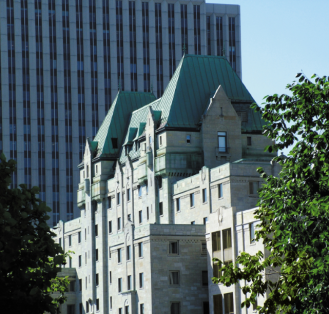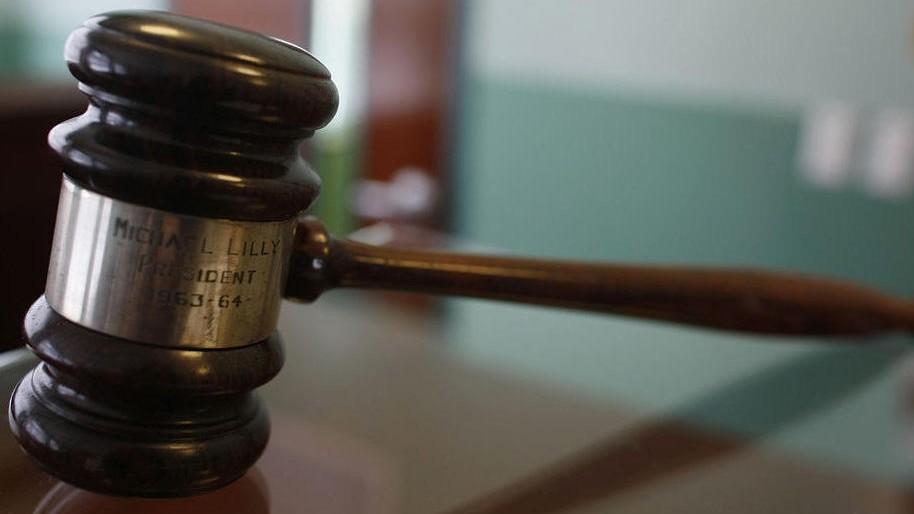Remember This? The Lord Elgin Hotel
Posted Jul 19, 2021 01:00:00 PM.
CityNews, in partnership with the Historical Society of Ottawa, brings you this weekly feature by Director James Powell, highlighting a moment in the Ottawa's history.
July 19, 1941
Across from Confederation Park on Elgin Street stands The Lord Elgin Hotel. Built in the French Chatêau style with a copper roof, and clad in the famous Queenston limestone from Niagara, the hotel has been an Ottawa landmark for 75 years.
While conceived prior to the outbreak of World War II, the hotel was erected during the first half of 1941, helping to alleviate the shortage of affordable accommodation in the nation's capital, made worse by an influx of thousands of service men and women.
So urgent was the housing crisis, 1,000 tons of steel and 30,000 tons of other construction materials were appropriated for the hotel's construction, despite pressing war-related needs. The municipal government also provided considerable financial inducements to the owner of the building.

The Lord Elgin Hotel. Photo/ Phixed
According to John Udd, the President of the Ford Hotels Company that built and managed The Lord Elgin, the construction of a hotel in Ottawa had been his dream since 1930. However, it was the City of Ottawa that made the first overture in February 1939 when a delegation of city officials canvassed hotel chains in the United States and Canada with a view to finding a hotel company willing to build a modern, fireproof hotel in Ottawa. The delegation eventually chose the Ford Hotels group based in Rochester, N.Y. that operated major hotels in Toronto and Montreal as well as Buffalo, Rochester, and Erie in the United States.
Serious negotiations were subsequently held between Udd and the federal and municipal governments in the spring of 1940 with a final agreement reached in July of that year. Udd is reported to have said that the “entire undertaking was conceived and determined at Laurier House [Prime Minister Mackenzie King's residence] in the relatively short course of an informal interview.” King indicated Dominion support for the venture as long as the building was consistent with government plans aimed at beautifying the capital.
The City of Ottawa and Udd agreed that Ford Hotels would erect a hotel of at least 350 rooms, each equipped with a private bath or shower, at a cost of at least $900,000 in downtown Ottawa. Design upgrades to win the Prime Minister's support plus other improvements brought the bill to $1.5-million (equivalent to roughly $23.5-million today).
The hotel's Elgin Street site was made possible when the Dominion government agreed to let a portion of the land to the Ford group for $5,000 per year with a 99-year lease.
The contract also called for the edifice to have a “pleasing stone exterior,” and would be constructed using local labour and materials as far as possible.
The room rates would start at a modest $2.50 per day for single occupancy and $3.50 for double occupancy.
The city furthermore agreed to provide a sizeable property tax break.
The hotel's assessment for tax purposes was fixed at one third of its normal assessed value for fifteen years. There was considerable opposition to this concession at City Council. Opponents noted that such concessions were not granted to the hotel chain for the construction of similar hotels in Toronto and Montreal. They also argued that a tax break would be unfair to competitors. However, the hotel’s supporters won the council debate. They pointed to the amount of new construction spending that would be brought to the city as well as the hotel’s expected annual payroll. Although the property taxes paid to the city would be temporarily reduced, they would still amount to $15,000 per year. It was also hoped that the hotel would attract U.S. tourists to the capital, bringing with them much needed U.S. dollars—an important consideration during the war years when Canada was desperate for American currency to buy war materiel.
Once the contract was signed, attention turned to the name for the new hotel.
Hundreds of names were proposed by the general public. Among the favourites were the “Kingsford,” a catchy combination of the Prime Minister's name and the name of the hotel chain. Other options included the “Empire,” the “Tweedsmuir,” after Canada’s much-loved Governor General who died in office in early 1940, the “Churchill,” after Britain's Prime Minister, and “The Lord Elgin,” after James Bruce, the 8th Earl of Elgin, who was the governor general of the Province of Canada from 1847-54.
The street on which the hotel was to be constructed was already named in his honour.
The original idea for “The Lord Elgin” came from Ottawa resident C. Sheppard in a letter to the Ottawa Citizen’s editor. It was later championed at City Hall by Alderman H. P. Hill Jr. After two ballots, City Council’s Industry and Publicity Committee unanimously chose it for the new hotel. The name was subsequently approved by John Udd on behalf of the Ford Hotels Company.
The ink was scarcely dry on the contract when construction work began on the new hotel.
Mayor Stanley Lewis turned the first sod in late September 1940. Its architects were Messrs Ross & Macdonald of Montreal, the successor firm that designed the Chatêau Laurier Hotel and Union Station a generation earlier. The main contractor was John Wilson of Ottawa.
Following the erection of the hotel's steel girders, which began at the beginning of January 1941, the building was constructed by skilled masons in six months. Each stone of the hotel was cut at the quarry to a pattern, numbered, and shipped to Ottawa for assembly like a big jig-saw puzzle.
While most workers came from Ottawa, there was a shortage of masons, scores of whom were needed for the project. The contractor said that they “had to raise a cry to gather the old Scottish masons to a sufficient number for the job.”
By the end of February, work was sufficiently advanced to allow Prime Minister Mackenzie King to lay the cornerstone of the new hotel. At the ceremony, he praised the co-operation of all parties that had made the hotel possible. He also underscored the appropriateness of naming the hotel after Lord Elgin saying “few names in Canadian history were more associated with freedom than Lord Elgin.”
It was during Elgin’s tenure as Governor General during the mid-nineteenth century that responsible government came to Canada. Elgin’s successful trip to Bytown, later called Ottawa, in 1853 also marked the first step towards the city being named Canada’s capital by Queen Victoria in 1857. King also thought it appropriate that the new hotel was located on the corner of Elgin Street and Laurier Avenue as it was Sir Wilfrid Laurier that initiated plans to beautify the capital. The prime minister likened Elgin Street and its approach to the Parliament Buildings to Pennsylvania Avenue in Washington, Whitehall Street in London, and the Avenue Champs-Élysées in Paris.
At lunchtime on Thursday the July 17, 1941, the brand-new hotel was officially opened.
Mayor Lewis had the honour of cutting a white silk ribbon that was bound around the four pillars of the hotel's porte cochère that protected arriving guests from the elements. The mayor was handed the shears by the ten year-old daughter of the city’s controller, Chester Pickering, who did much to make the hotel a reality. The Prime Minister’s car then drove up to the hotel’s entrance to be met by civic officials and senior hotel officials, including John Udd, president of the Ford Hotels Company and Richard Ford, the company’s chairman of the board.
Inside, the prime minister unveiled two marble busts of the 8th Earl and Countess of Elgin and Kincardine that were donated to the Dominion by the 10th Earl with the intention that they be put on display in the new hotel that bore the name of his illustrious grandfather. The bust of Lord Elgin was made by William Behnes, while that of the Countess was by Amelia Hill. The busts were brought to Canada from the Bruce family home in Scotland on a Royal Navy warship. Afterwards, the prime minister and Udd sent telegrams of thanks to the 10th Earl. Mackenzie King then signed the hotel’s register as its first guest, followed by Mayor Lewis. Then came a celebratory lunch for one hundred guests in the dining room and a hotel tour.
The Lord Elgin was designed with relatively few of the facilities commonly expected in a hotel of this calibre.
Hotel management stressed that there was no ballroom or grill, and that the “beverage rooms” were of modest scale aimed to serve the needs of its transient residents rather than compete with existing bars and restaurants in the city. Room service was provided, however, by Murray’s Lunch, a new, independent restaurant that could be accessed through the hotel’s premises as well as from the street.
Entering the lobby on the ground floor of the twelve-storey hotel, one could find directly ahead, the registration desk, an information desk and a cashier’s wicket. To the right of the entrance was a newsstand and a passageway to Murray’s Lunch and the bank of elevators. To the left was a travel and transportation desk, along with a corridor to a convention room, beverage rooms, and the barber and hair salon.
The “men's” beverage room had a club-like atmosphere, and could accommodate 150 persons. It was furnished with settees and light-coloured furniture. The table tops were blue with a mark-proof veneer. The “ladies'” beverage room was larger, holding 250 persons. Its colours were grey, mauve and orchid. Both beverage rooms were air-conditioned.
The hotel boasted 371 private guest rooms, each with private washrooms, located on the second to twelfth stories.
The lower stories each had 46 guestrooms, while upper level floors had either 31 or 16 larger guestrooms or suites. Rooms were decorated in three colour schemes, with matching drapes and appointments. The lower three guest floors were decorated in blue-grey and dusty rose, the next four floors were in mauve and dusty rose, while the upper floors were in suntan buff and ivory. Drapes had a matching floral design. Instead of antiseptic white, the bathrooms were painted a suntan buff with ivory baked enamel walls. For the comfort of the guests, the bathroom floors were made of rubber rather than tile. Guestrooms were furnished in natural oak, with four armchairs.
The hotel noted with pride that beds were five inches longer than usual with a reading lamp mounted onto the headboards. Each room was also equipped with a radio built into the telephone stand. Residents had their choice of two channels. Each room door was equipped with an indicator to alert the maid to whether the room was occupied. Although guestrooms were not air-conditioned, they had casement windows with extension hinges that the hotel claimed induced air currents to enter the room regardless of wind direction. Doors were also equipped with “peek-proof” ventilators.
On opening day, The Lord Elgin had a staff of 225, most of whom were women, with a payroll of roughly $200,000 per annum. Indicative of the close relationship the hotel had with the municipal government, both the hotel’s manager, Redverse F. Pratt, and the night manager, Gerald Cherry, were both previously employed by the Ottawa Tourist Bureau. Chester Pickering, member of the Ottawa’s Board of Control, later joined the hotel’s board of directors.
In 1949, the Ford Hotels Company was acquired by the Sheraton Group of hotels. Shortly thereafter it was reported that Sheraton Hotels had sold The Lord Elgin to a group of Ottawa and Montreal businessmen. President of the new company was Mr P. H. Bruneau of Montreal. Chester Pickering was named vice-president. The hotel subsequently changed hands several times. The Lord Elgin has been owned by Ottawa’s Gillin family since 1987.
In 2003, the busts of Lord and Lady Elgin were moved to Rideau Hall for an exhibit on the contribution the Earl made to Canadian culture and democracy. They were never returned despite entreaties from the hotel. Government officials argued that the busts were only “on loan” to the hotel, and could be moved at any time.
The hotel replaced the busts with replicas.
Possibly to make partial amends, the National Capital Commission loaned a portrait of Lord Elgin to the hotel in 2015 to help celebrate the hotel’s 75th anniversary. Previously, the painting had hung in Rideau Hall. The portrait, which was purchased by Lord Grey, a later governor general, in 1907 is believed to have been painted at the beginning of the 20th century by an unknown artist in the style of Sir Francis Grant. The portrait is currently on display in the hotel’s lobby.








